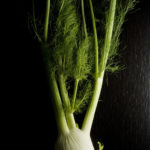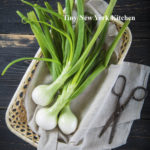Fennel is a member of the carrot family, though it is not a root vegetable. The base of its long stalk weaves together to form a thick and crisp bulb that grows above ground. Fennel’s leaves, seeds, and stems all have a sweet, faintly anise like flavor. The stems of fennel swell and overlap at the base of the plant to form a bulb with white to pale green ribbed layers that are similar to celery in appearance and texture. Light and feathery, the pretty green leaves slightly resemble fresh dill. Use them as a bed for steaming fish or in small amounts as a garnish.
Originating in the Mediterranean, the fennel bulb appears often in Italian and Scandinavian cuisines. It can be eaten raw, grilled, baked, braised, or sautéed. While grilling, you can toss a handful of dried or fresh fennel stems onto the charcoal to infuse meat or fish with a light anise flavor.
When selecting fennel choose fresh bulbs that are smooth and tightly layered with cracks or bruises. Fat, rounded bulbs with white and pale green color will tend to be more succulent than thin or yellow ones. Avoid any with wilted leaves or dried layers. Now available year-round, fennel is at its peak from late fall through winter. Grocers sometimes incorrectly liable fennel as sweet anise.
When storing, keep fennel bulbs in a perforated plastic bag in the refrigerator for up to 5 days. If kept too long, they will lose their flavor and toughen.
When preparing, remove the green stems and leaves, saving them to flavor or garnish other dishes such as soups or fish. Discard the outer layer of the bulb if it is tough and cut away any discolored areas. Cut the bulb in half lengthwise and remove the base of the core as it is thick and solid. Gently separate the layers with your hands and rinse well to remove any grit between them. Slice or cut as your recipe directs.
©Tiny New York Kitchen © 2021 All Rights Reserved
One of the wonderful things about spring is access to spring onions. Spring onions are typically planted at the end of summer so that they grow over the winter months, ready for harvesting in the spring.
Spring onions are more mature than both scallions and green onions, but are still a type of young onion, which are picked before they have a chance to grow larger. You can identify a spring onion by the small, round, white bulb at its base. While it appears similar to scallions and green onions, its rounded bulb gives it way.
Spring onions are also slightly stronger in flavor than scallions and green onions due to their maturity. They still have a gentler flavor than regular onions, which have been left in the ground much longer and grow much larger.
To prepare spring onions wash them under running water to free them of any dirt and grit. Trim the root end, but only the very, very end. Every last bit of white packs a lot of flavor. If you’re braising or grilling them whole just trim off the top most inch of the greens and you’re done.
If you are using spring onions where you would use scallions the prep is nearly the same. Slice them thinly crosswise for adding to a salad or a vinaigrette. If you’re using them in a stir-fry, cut them on the bias.
©Tiny New York Kitchen © 2021 All Rights Reserved







